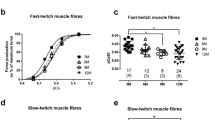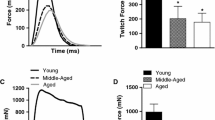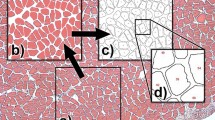Synopsis
Serial frozen sections of longissimus dorsi muscles from seven pigs at different live weights (13 to 127 kg) were reacted for ATPase by the calcium method at an alkaline pH and for NADH oxidative activity. One hundred muscle fibres from each animal were identified individually in serial sections and their staining intensity was measured with a microscope photometer at 600 nm. For each section, staining intensity of fibres (% tranmission) was measured and converted to the nearest one-tenth unit of the range from the darkest to the lightest staining fibres. Frequency of occurrence of fibre types was plotted on a 10×10 grid using the range co-ordinates for NADH oxidative activity (vertical) and ATPase activity (horizontal). The commonly recognized histochemical fibre types in this muscle appeared as crowded areas in the grid but, in many cases, these areas were part of a continuous ‘L’ shaped distribution. In fibres having an ATPase staining intensity of 1.0 and 0.9 units of the range, a continuous but skewed distribution with regard to NADH oxidative activity was detected. In fibres with NADH oxidative activity of 0.6 to 1.0 units of the range, a continuous but irregular distribution with regard to ATPase activity was detected. Within this range, there was some evidence of a growth-related shift towards weaker ATPase activity.
Similar content being viewed by others
References
Ashmore, C. R., Tompkins, G. &Doerr, L. (1972). Postnatal development of muscle fiber types in domestic animals.J. Anim. Sci. 34, 37–41.
Bendall, J. R. (1975). Cold-contracture and ATP-turnover in the red and white musculature of the pig, postmortem.J. Sci. Fd Agric. 26, 55–71.
Burke, R. E., Levine, D. N., Zajac, F. E., Tsairis, P. &Engel, W. K. (1971). Mammalian motor units: Physiological-histochemical correlation in three types in cat gastrocnemius.Science 174, 709–12.
Close, R. I. (1972). Dynamic properties of mammalian skeletal muscles.Physiol. Rev. 52, 129–97.
Cooper, C. C., Cassens, R. G. &Briskey, E. J. (1969). Capillary distribution and fiber characteristics in skeletal muscle of stress-susceptible animals.J. Fd Sci. 34, 299–302.
Cooper, C. C. Cassens, R. G., Kastenschmidt, L. L. &Briskey, E. J. (1970). Histochemical characterization of muscle differentiation.Dev. Biol. 23, 169–84.
Davies, A. S. (1972). Postnatal changes in the histochemical fibre types of porcine skeletal muscle.J. Anat. 113, 213–40.
Engel, W. K. (1974). Fiber-type nomenclature of human skeletal muscle for histochemical purposes.Neurology (Minneapolis) 24, 344–8.
Engel, W. K. &Brooke, M. H. (1966). Muscle biopsy as a clinical diagnostic aid. In:Neurological Diagnostic Techniques (ed. W. S. Fields). Springfield, Illinois: Charles C. Thomas.
Guth, L. (1973). Fact and artifact in the histochemical procedure for myofibrillar ATPase.Expl Neurol. 41, 440–50.
Guth, L. &Samaha, F. J. (1970). Procedure for the histochemical demonstration of actomyosin ATPase.Expl Neurol. 26, 365–7.
Moody, W. G. &Cassens, R. G. (1968). Histochemical differentiation of red and white muscle fibers.J. Anim. Sci. 27, 961–8.
Nolte, J. &Pette, D. (1972). Microphotometric determination of enzyme activity in single cells in cryostat sections. II. Succinate dehydrogenase, lactate dehydrogenase and triosephosphate dehydrogenase activities in red, intermediate and white fibers of soleus and rectus femoris muscles of rat.J. Histochem. Cytochem. 20, 577–82.
Samaha, F. J. &Yunis, E. J. (1973). Quantitative and histochemical demonstration of a calcium activated mitochondrial ATPase in skeletal muscle.Expl Neurol. 41, 431–9.
Schmalbruch, H. &Kamieniecka, Z. (1975). Histochemical fiber typing and staining intensity in cat and rat muscles.J. Histochem. Cytochem. 23, 395–401.
Swatland, H. J. (1975a). Histochemical development of myofibres in neonatal piglets.Res. vet. Sci. 18, 253–257.
Swatland, H. J. (1975b). Relationships between mitochondrial content and glycogen distribution in porcine muscle fibres.Histochem. J. 7, 459–69.
Van Den Hende, C., Muylle, E., Oyaert, W. &De Roose, P. (1972). Changes in muscle characteristics in growing pigs. Histochemical and electron microscopic study.Zentbl. Vet. Med. A. 19, 102–10.
Author information
Authors and Affiliations
Rights and permissions
About this article
Cite this article
Swatland, H.J. Transitional stages in the histochemical development of muscle fibres during post-natal growth. Histochem J 9, 751–757 (1977). https://doi.org/10.1007/BF01003069
Received:
Revised:
Issue Date:
DOI: https://doi.org/10.1007/BF01003069




